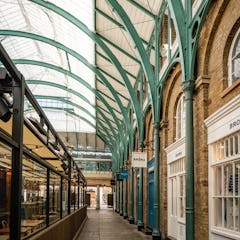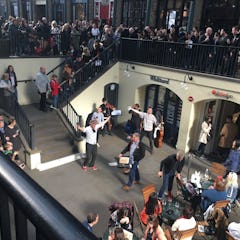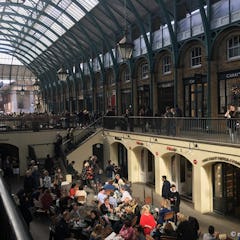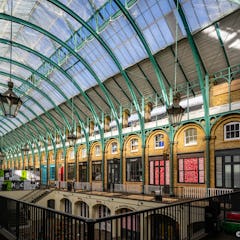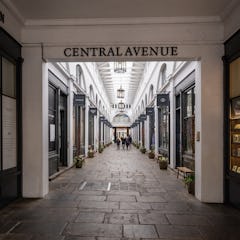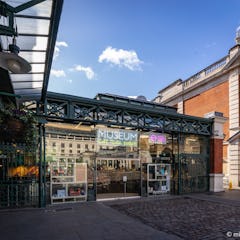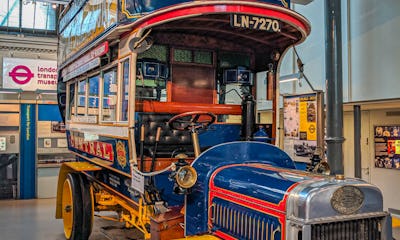History – From Monastery Garden to Cultural Hub
Few would guess that Covent Garden’s bustling square was once just a simple garden. In the Middle Ages, the land belonged to Westminster’s Benedictine monks and served as the monastery’s kitchen garden. Over time, the name “Convent Garden” evolved into its current form.
Everything changed in the 16th century, when King Henry VIII dissolved the monasteries and took control of the area. The land later passed to the family of the Earl of Bedford, but it remained undeveloped for a long time. Not until the 17th century did Francis Russell, the 4th Earl of Bedford, conceive the idea of transforming the area into a noble residential district, commissioning Inigo Jones as its planner.
Jones created something entirely new for London: an Italian-style piazza that quickly became the darling of high society. Alongside the piazza rose St. Paul’s Church.
Architecture – Piazzas, Halls, and Layers of Time
Market activity sprang up around the piazza almost immediately. The first mentions of Covent Garden’s markets date back to the 1650s, and in the 1670s, King Charles II granted formal permission for market trading. Vegetables, fruits, flowers, and herbs were sold on the square—at one point, even pineapples, which became a symbol of the entire market.
Through the 18th century, the markets expanded, and upper floors were added to accommodate more refined shops. Finally, in the early 19th century, architect Charles Fowler was tasked with designing a new, more orderly market hall. Thus was born the Apple Market, whose graceful glass roofs and iron structures lend the space a sense of openness and light. It remains one of the area’s architectural jewels.
Wandering Covent Garden’s streets today, you can still see echoes of Inigo Jones’s era alongside Victorian market buildings and restored façades, housing everything from small boutiques to theatres and top restaurants.
Meanwhile, the Bridge of Aspiration, a modern addition to the area’s architecture, spans Floral Street. This spiral-glass footbridge connects the Royal Opera House to the adjacent Royal Ballet School. Completed in 2003 and designed by WilkinsonEyre Architects, its name alludes to young ballet students crossing from school to the Royal Opera House stage to pursue their dreams.
Markets – Apple Market and Jubilee Market
At the heart of Covent Garden beats a living market tradition. Today, the Apple Market offers crafts, jewellery, and antiques, and on Mondays, the hall fills with vendors selling vintage items. Cafés and restaurants contribute to the bustle, while, for example, a Moomin shop adds a touch of Nordic charm.
On the opposite side of the piazza lies the Jubilee Market, a more modern covered market. Depending on the day of the week, you’ll find antiques, handcrafted goods, and unique finds. Street performers and live music around the markets keep the atmosphere lively, especially on weekends.
Shopping
Covent Garden is a shopper’s dream, where international luxury brands meet independent design boutiques. Floral Street and Long Acre are primarily known for fashion retailers, but brick-and-mortar shops across the area also offer cosmetics, jewellery, and lifestyle goods. Additionally, rotating pop-up stores and seasonal installations ensure that the shopping experience remains fresh.
Royal Opera House – Art and Experiences
Covent Garden’s cultural epicentre is the Royal Opera House, which has been a stage for the arts since the 18th century. The current building dates mainly from the 19th century and underwent extensive restoration in the 1990s. You can enter from Bow Street or directly from the Piazza.
Discounted tickets are available for young people, and guided tours offer a behind-the-scenes glimpse into sets and costume workshops. Upstairs, the Piazza Restaurant and Terrace Bar serves modern British cuisine with stunning piazza views—and is also open to non-theatregoers. Additionally, the Royal Opera House Dining Room offers a high-quality dinner experience before attending a performance.
Right beside (or behind, if viewed from the piazza) the opera house, visitors often pause to admire Enzo Plazzotta’s Young Dancer sculpture and the five iconic red telephone booths, which have become a favourite photo spot.
Theatres in Covent Garden
Covent Garden is part of London’s legendary West End and is home to many renowned theatres. The Lyceum Theatre draws families with Disney’s The Lion King musical, while the Duchess Theatre often features lighter, comedic fare. Nearby, the Theatre Royal Drury Lane is one of the oldest theatres still in operation in the world, an attraction in its own right.
Many local restaurants offer convenient theatre menus, making dinner on show nights effortless. Popular choices include Balthazar, Clos Maggiore, Cora Pearl, The Ivy Market Grill, and Joe Allen, all at a short walking distance from the theatres.
Events – Culture All Year Round
Covent Garden is one of those London spots where there’s always something happening. In spring, the piazza bursts into bloom during the Covent Garden in Bloom event. In the summer, the area is filled with outdoor concerts, opera performances, and street artists.
In the autumn, Halloween in Covent Garden features pumpkin installations and themed events; during the Christmas season, the entire district is illuminated with festive lights. Mid-November’s Covent Garden Christmas Lights Switch-On illuminates the area, and the Covent Garden Christmas Village pops up around the piazza with its seasonal market. At the start of the year, Lunar New Year celebrations bring their vibrant colour to the streets.
Street performers enrich the piazza year-round—on any given day, you might encounter world-class jugglers, musicians, or magicians.
Seven Dials – A Tranquil Crossroads in the Heart of Culture
If you need a moment’s respite from the piazza’s bustle, head toward Seven Dials. This star-shaped intersection, where seven streets branch out, offers a calmer atmosphere.
The area’s lanes boast delightful fashion boutiques, craft shops, and design stores. Seven Dials is also known for its cosy cafés and small boutique hotels. Regular small festivals, exhibitions, and cultural events take place here, and historic ground-floor buildings with charming façades complete the locale’s inviting ambience.
